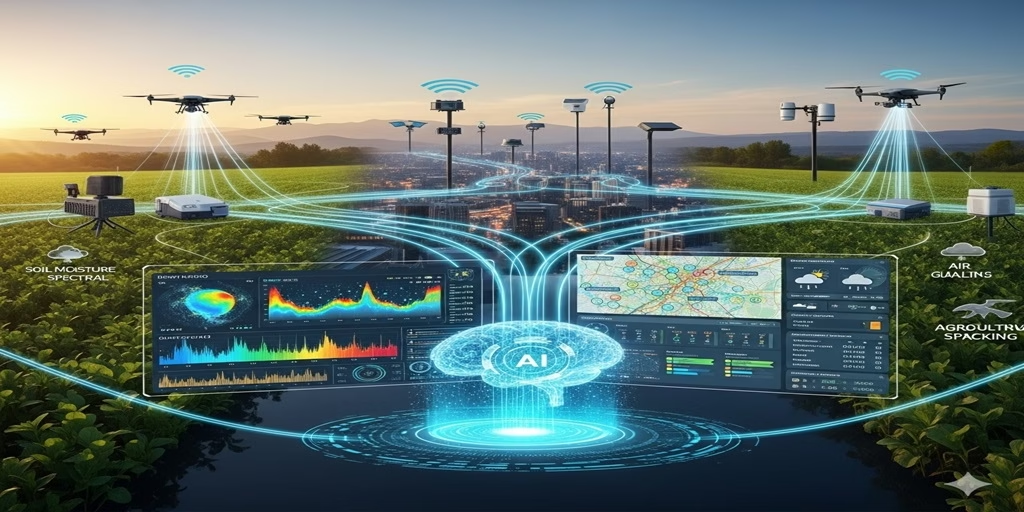Why Are Environmental Sensors Crucial in the Age of AI?
Sensor Introduction
In the grand symphony of modern technology, AI is often seen as the star conductor—the genius mind orchestrating complex tasks, from driving cars to diagnosing diseases. But a conductor, no matter how brilliant, is useless without an orchestra. For artificial intelligence, the environmental sensors scattered across our planet are its orchestra—the eyes, ears, and nerves that provide the raw, real-time data it needs to truly understand and interact with the world around us.
This relationship isn’t just beneficial; it’s foundational. Without the constant, high-fidelity data stream from a vast network of sensors, AI would be a brain without a body—a powerful but isolated intelligence with nothing to perceive and no way to act. The true value of environmental sensors in the AI era lies in this symbiotic relationship, transforming AI from a theoretical tool into a powerful engine for environmental management, sustainability, and global resilience.
The Foundational Role: Data Is the New Lifeblood
The saying “data is the new oil” has been a cliché for years, but in the context of AI, it’s not just a commodity; it’s a living resource. AI systems don’t just consume data; they depend on a continuous, dynamic supply to learn, adapt, and make informed decisions.
Environmental sensors fulfill this critical need by providing what can be called “living data.” Unlike static data sets collected periodically by humans, sensors deliver information that is:
- Real-time and Continuous: They provide a constant stream of measurements, allowing AI models to track changes as they happen. A traditional weather station might take a reading every hour; a network of IoT sensors can do so every minute, providing a much richer, more granular picture of atmospheric conditions.
- High-Fidelity and Multi-dimensional: Sensors can measure a multitude of variables simultaneously—temperature, humidity, barometric pressure, UV index, particulate matter, and more. This multi-dimensional data allows AI to see the full picture, identifying complex correlations that a human observer might miss.
- Massive in Scale: A single sensor is useful, but when you network millions of them together across cities, farms, forests, and oceans, the sheer volume of data becomes staggering. This massive scale is precisely what AI is designed to handle, using machine learning algorithms to find patterns and insights that would be impossible for humans to process.
In essence, if AI is the brain, environmental sensors are the sensory nervous system. They collect the raw inputs from the world, feeding them into the AI engine so it can perceive, process, and ultimately, respond.
Transforming Fields: From Theory to Action
The synergy between environmental sensors and AI is not a hypothetical concept; it’s actively revolutionizing industries and enabling applications that were once the stuff of science fiction.
1. Climate Science and Disaster Management
For decades, climate models were limited by the sparse data available from satellites and scattered weather stations. Today, AI-powered systems are analyzing data from a dense network of sensors to create more accurate and timely climate predictions.
- Predicting Extreme Weather: By processing real-time sensor data on air pressure, temperature, wind speed, and humidity, AI models can predict the path and intensity of hurricanes, floods, and wildfires with unprecedented accuracy. This allows for earlier evacuation orders and more effective disaster preparedness, saving lives and reducing economic damage.
- Tracking Pollution: AI analyzing data from air quality sensors in smart cities can pinpoint sources of pollution in real-time. It can identify which industrial plant, intersection, or even vehicle type is contributing the most, enabling regulatory bodies to take targeted action.
2. Smart Agriculture (AgriTech)
The future of feeding a growing global population lies in “precision agriculture,” and sensors are the key enablers.
- Optimizing Resource Use: Sensors placed in fields measure soil moisture levels, nutrient content, and pH. AI analyzes this data to create a “prescription map” for the farm, telling automated irrigation systems exactly where and when to water, and smart tractors where to apply fertilizer. This not only increases crop yield but also drastically reduces water consumption and chemical runoff, leading to more sustainable farming.
- Pest and Disease Detection: AI-powered cameras and acoustic sensors can monitor crops for early signs of disease or pest infestations. By identifying problems before they spread, farmers can apply targeted treatments, avoiding the need to blanket an entire field with pesticides.
3. Urban Management and Smart Cities
Sensors are the building blocks of the smart city, turning a collection of buildings into a responsive, intelligent ecosystem.
- Traffic and Mobility: Traffic flow sensors provide real-time data to an AI system that can dynamically adjust traffic light timings to reduce congestion and cut down on vehicle emissions. AI can even predict traffic patterns based on time of day and events, preemptively optimizing the flow.
- Water and Energy Grids: Sensors monitor pressure in water pipes to detect leaks, with AI pinpointing the exact location for repair crews to fix, saving millions of gallons of water. Similarly, smart meters provide AI with real-time data on energy consumption, allowing the grid to efficiently distribute power and prevent blackouts.
4. Biodiversity and Conservation
The use of sensors and AI is providing unprecedented insight into our planet’s wild places.
- Monitoring Wildlife: In remote forests, acoustic sensors can listen for the distinct calls of endangered species. AI models, trained on a database of animal sounds, can automatically identify and track populations, providing conservationists with vital data without the need for intrusive physical monitoring.
- Tracking Illegal Activity: Thermal and visual sensors combined with AI can detect illegal logging, poaching, or fishing activities, automatically alerting authorities and helping to protect fragile ecosystems.
The Inseparable Link: Why Sensors Alone Aren’t Enough
It’s easy to look at a sensor and think it’s a “smart” device, but it isn’t. A sensor only provides raw data: “The temperature is 25 degrees Celsius.” The true intelligence comes when that data is fed into an AI system.
- Sensors Collect, AI Understands: A network of air quality sensors might report high levels of particulate matter across a city. But it’s the AI model that can analyze that data in conjunction with traffic patterns, wind direction, and factory emissions schedules to understand why the pollution is happening and where it’s coming from.
- Sensors Observe, AI Predicts: A soil moisture sensor tells you the ground is dry right now. An AI system, using data from that sensor plus weather forecasts, can predict that the soil will become critically dry in three days and proactively trigger the irrigation system, preventing crop stress before it happens.
- Sensors Provide Input, AI Delivers Insight: An underwater sensor might detect an unusual chemical signature. AI can cross-reference that signature with a vast database of chemical compositions, identify it as a known pollutant, trace its likely source based on ocean currents, and alert an environmental agency—all in a matter of seconds.
Without the AI, the sensor data is just a collection of numbers—a vast, unintelligible log. The AI provides the context, the intelligence, and the predictive power that turns raw data into actionable insights and automated solutions.
The Path Forward: Challenges and Opportunities
While the synergy is powerful, challenges remain. The deployment of a truly global sensor network is a massive undertaking, facing hurdles in cost, data standardization, and interoperability. Furthermore, issues of data security and privacy are paramount. As sensors collect more intimate details about our environment and our lives within it, who owns and protects that data becomes a critical question.
However, these challenges are outweighed by the immense opportunities. As sensors become smaller, cheaper, and more energy-efficient, and as AI models become more powerful and accessible, we are at the precipice of a new era. This isn’t just about making our lives more convenient; it’s about building a more resilient, sustainable, and intelligent planet.
In the end, AI and environmental sensors are not two separate technologies but two halves of a whole. They form a feedback loop of perception and action, a nervous system that will allow us to monitor the health of our planet like never before and to respond with the speed and intelligence that today’s global challenges demand.
Share this:
- Click to share on Facebook (Opens in new window) Facebook
- Click to share on X (Opens in new window) X
- Click to share on WhatsApp (Opens in new window) WhatsApp
- Click to email a link to a friend (Opens in new window) Email
- Click to share on Reddit (Opens in new window) Reddit
- Click to share on LinkedIn (Opens in new window) LinkedIn
- Click to share on Pinterest (Opens in new window) Pinterest
- Click to share on Telegram (Opens in new window) Telegram
Related
Discover more from ChenAnIoT
Subscribe to get the latest posts sent to your email.





